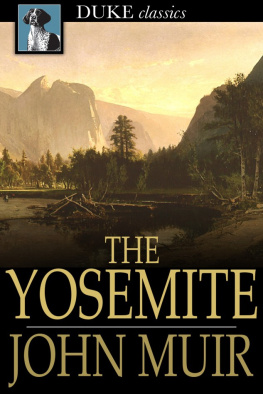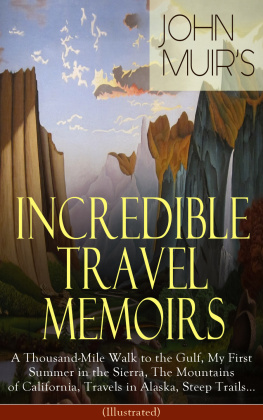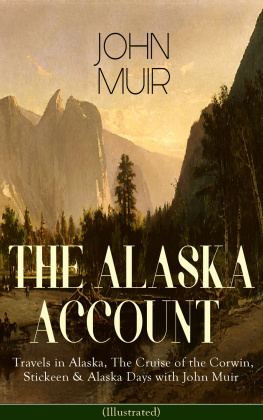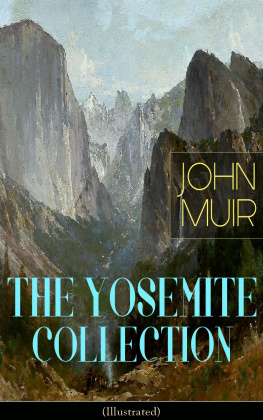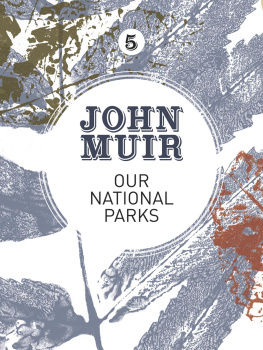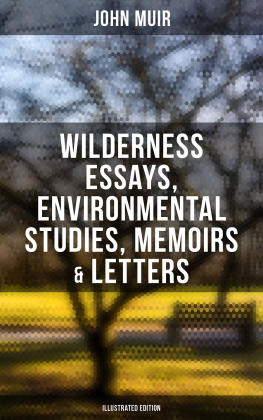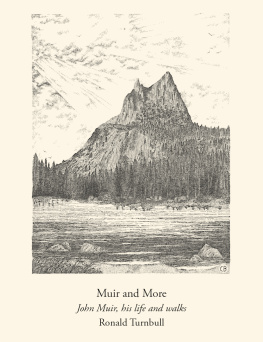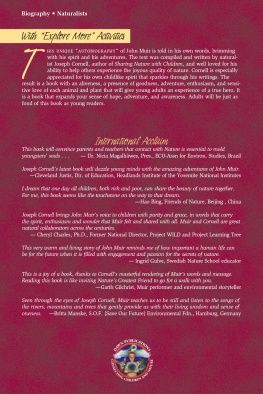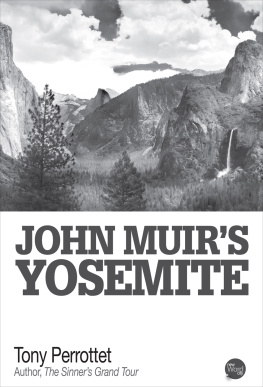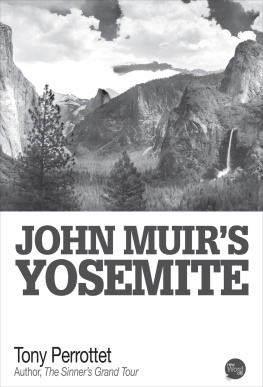John Muir - The Yosemite
Here you can read online John Muir - The Yosemite full text of the book (entire story) in english for free. Download pdf and epub, get meaning, cover and reviews about this ebook. year: 2013, publisher: Duke Classics, genre: Art. Description of the work, (preface) as well as reviews are available. Best literature library LitArk.com created for fans of good reading and offers a wide selection of genres:
Romance novel
Science fiction
Adventure
Detective
Science
History
Home and family
Prose
Art
Politics
Computer
Non-fiction
Religion
Business
Children
Humor
Choose a favorite category and find really read worthwhile books. Enjoy immersion in the world of imagination, feel the emotions of the characters or learn something new for yourself, make an fascinating discovery.
The Yosemite: summary, description and annotation
We offer to read an annotation, description, summary or preface (depends on what the author of the book "The Yosemite" wrote himself). If you haven't found the necessary information about the book — write in the comments, we will try to find it.
Renowned naturalist John Muir is widely credited as being one of the important early figures in the conservation movement. In this series of essays, Muir introduces readers to the wonders of the majestic Yosemite region, a place he visited as soon as he arrived in America in 1868. The beauty of the areas mountains, lakes, and vistas inspired Muir to devote himself to nature and its preservation.
The Yosemite — read online for free the complete book (whole text) full work
Below is the text of the book, divided by pages. System saving the place of the last page read, allows you to conveniently read the book "The Yosemite" online for free, without having to search again every time where you left off. Put a bookmark, and you can go to the page where you finished reading at any time.
Font size:
Interval:
Bookmark:

First published in 1912
ISBN 978-1-62012-828-2
Duke Classics
2013 Duke Classics and its licensors. All rights reserved.
While every effort has been used to ensure the accuracy and reliability of the information contained in this edition, Duke Classics does not assume liability or responsibility for any errors or omissions in this book. Duke Classics does not accept responsibility for loss suffered as a result of reliance upon the accuracy or currency of information contained in this book.
Affectionately dedicated to my friend,
Robert Underwood Johnson,
faithful lover and defender of our glorious forests
and originator of the Yosemite National Park.
On the early history of Yosemite the writer is indebted to Prof. J. D.Whitney for quotations from his volume entitled "Yosemite Guide-Book,"and to Dr. Bunnell for extracts from his interesting volume entitled"Discovery of the Yosemite."
When I set out on the long excursion that finally led to California Iwandered afoot and alone, from Indiana to the Gulf of Mexico, with aplant-press on my back, holding a generally southward course, like thebirds when they are going from summer to winter. From the west coastof Florida I crossed the gulf to Cuba, enjoyed the rich tropical florathere for a few months, intending to go thence to the north end of SouthAmerica, make my way through the woods to the headwaters of the Amazon,and float down that grand river to the ocean. But I was unable to find aship bound for South Americafortunately perhaps, for I had incrediblylittle money for so long a trip and had not yet fully recovered froma fever caught in the Florida swamps. Therefore I decided to visitCalifornia for a year or two to see its wonderful flora and the famousYosemite Valley. All the world was before me and every day was aholiday, so it did not seem important to which one of the world'swildernesses I first should wander.
Arriving by the Panama steamer, I stopped one day in San Francisco andthen inquired for the nearest way out of town. "But where do you want togo?" asked the man to whom I had applied for this important information."To any place that is wild," I said. This reply startled him. He seemedto fear I might be crazy and therefore the sooner I was out of town thebetter, so he directed me to the Oakland ferry.
So on the first of April, 1868, I set out afoot for Yosemite. It was thebloom-time of the year over the lowlands and coast ranges the landscapesof the Santa Clara Valley were fairly drenched with sunshine, all theair was quivering with the songs of the meadow-larks, and the hills wereso covered with flowers that they seemed to be painted. Slow indeed wasmy progress through these glorious gardens, the first of the Californiaflora I had seen. Cattle and cultivation were making few scars as yet,and I wandered enchanted in long wavering curves, knowing by my pocketmap that Yosemite Valley lay to the east and that I should surely findit.
Looking eastward from the summit of the Pacheco Pass one shiningmorning, a landscape was displayed that after all my wanderings stillappears as the most beautiful I have ever beheld. At my feet lay theGreat Central Valley of California, level and flowery, like a lake ofpure sunshine, forty or fifty miles wide, five hundred miles long, onerich furred garden of yellow Compositoe. And from the eastern boundaryof this vast golden flower-bed rose the mighty Sierra, miles in height,and so gloriously colored and so radiant, it seemed not clothed withlight, but wholly composed of it, like the wall of some celestial city.Along the top and extending a good way down, was a rich pearl-gray beltof snow; below it a belt of blue and dark purple, marking the extensionof the forests; and stretching along the base of the range a broad beltof rose-purple; all these colors, from the blue sky to the yellowvalley smoothly blending as they do in a rainbow, making a wall of lightineffably fine. Then it seemed to me that the Sierra should be called,not the Nevada or Snowy Range, but the Range of Light. And after tenyears of wandering and wondering in the heart of it, rejoicing in itsglorious floods of light, the white beams of the morning streamingthrough the passes, the noonday radiance on the crystal rocks, theflush of the alpenglow, and the irised spray of countless waterfalls,it still seems above all others the Range of Light.
In general views no mark of man is visible upon it, nor any thing tosuggest the wonderful depth and grandeur of its sculpture. None of itsmagnificent forest-crowned ridges seems to rise much above the generallevel to publish its wealth. No great valley or river is seen, or groupof well-marked features of any kind standing out as distinct pictures.Even the summit peaks, marshaled in glorious array so high in the sky,seem comparatively regular in form. Nevertheless the whole range fivehundred miles long is furrowed with canyons 2000 to 5000 feet deep, inwhich once flowed majestic glaciers, and in which now flow and sing thebright rejoicing rivers.
Though of such stupendous depth, these canyons are not gloom gorges,savage and inaccessible. With rough passages here and there they areflowery pathways conducting to the snowy, icy fountains; mountainstreets full of life and light, graded and sculptured by the ancientglaciers, and presenting throughout all their course a rich variety ofnovel and attractive scenerythe most attractive that has yet beendiscovered in the mountain ranges of the world. In many places,especially in the middle region of the western flank, the main canyonswiden into spacious valleys or parks diversified like landscape gardenswith meadows and groves and thickets of blooming bushes, while the loftywalls, infinitely varied in form are fringed with ferns, floweringplants, shrubs of many species and tall evergreens and oaks that findfootholds on small benches and tables, all enlivened and made gloriouswith rejoicing stream that come chanting in chorus over the cliffs andthrough side canyons in falls of every conceivable form, to join theriver that flow in tranquil, shining beauty down the middle of eachone of them.
The most famous and accessible of these canyon valleys, and also the onethat presents their most striking and sublime features on the grandestscale, is the Yosemite, situated in the basin of the Merced River at anelevation of 4000 feet above the level of the sea. It is about sevenmiles long, half a mile to a mile wide, and nearly a mile deep in thesolid granite flank of the range. The walls are made up of rocks,mountains in size, partly separated from each other by side canyons, andthey are so sheer in front, and so compactly and harmoniously arrangedon a level floor, that the Valley, comprehensively seen, looks like animmense hall or temple lighted from above.
But no temple made with hands can compare with Yosemite. Every rock inits walls seems to glow with life. Some lean back in majestic repose;others, absolutely sheer or nearly so for thousands of feet, advancebeyond their companions in thoughtful attitudes, giving welcome tostorms and calms alike, seemingly aware, yet heedless, of everythinggoing on about them. Awful in stern, immovable majesty, how softly theserocks are adorned, and how fine and reassuring the company they keep:their feet among beautiful groves and meadows, their brows in the sky,a thousand flowers leaning confidingly against their feet, bathed infloods of water, floods of light, while the snow and waterfalls, thewinds and avalanches and clouds shine and sing and wreathe about themas the years go by, and myriads of small winged creatures birds, bees,butterfliesgive glad animation and help to make all the air intomusic. Down through the middle of the Valley flows the crystal Merced,River of Mercy, peacefully quiet, reflecting lilies and trees and theonlooking rocks; things frail and fleeting and types of endurancemeeting here and blending in countless forms, as if into this onemountain mansion Nature had gathered her choicest treasures, to drawher lovers into close and confiding communion with her.
Font size:
Interval:
Bookmark:
Similar books «The Yosemite»
Look at similar books to The Yosemite. We have selected literature similar in name and meaning in the hope of providing readers with more options to find new, interesting, not yet read works.
Discussion, reviews of the book The Yosemite and just readers' own opinions. Leave your comments, write what you think about the work, its meaning or the main characters. Specify what exactly you liked and what you didn't like, and why you think so.

